 V=-0.0078 cal/bar
V=-0.0078 cal/barII. Evolution of metamorphism and geodynamics
Experimental studies of mineral equilibria
Graphchikov A.A., and Konilov A.N. Experimental study of the parameters of charnockite assemblage existence in the system KAlO2-MgO-FeO-SiO2.
The experimental study of the parameters of charnockite assemblage existence in the system KAlO2-MgO-FeO-SiO2 has been completed in the presence of aqueous and aqueous-carbonic acid fluid at P=1-5 kbar. The position of the reaction of biotite-orthopyroxene-quartz parageneses partial melting has been determined. The dependence of solidus temperatures decrease on a growth in iron number of dark colored minerals has been calibrated. The water saturated and fluid absent melting of biotite-quartz assemblages was found to take place already at 700oC (Graphchikov & Konilov, 1996). The experimental results argue against the experimental data of Peterson and Newton (1990) on the low pressure melting of Bt-Qtz as-
14
semblage in a CO2 rich fluid. Our data agree with the conclusion of Clements (1993) that the presence of CO2 in the fluid has no other effect than a decrease in a (H2O) and, consequently, an increase in solidus temperature.
A thermodynamic processing of experimental data on the stability of charnockite assemblage has been performed. An agreement between experimental data and calculated positions of mineral reactions is possible only provided an essential deviation from the ideality of phlogopite-annite solid solution or at the negative values of mixing parameters of enstatite-ferrosilite solid solution. A mathematical model for the calculation of the value of water activity in the fluid in equilibrium with the Qtz+Kfs+Opx+Bt assemblage at any composition of Bt and Opx relative to Fe, Mg, and Al as well as the isotherms of component distribution between them have been proposed. A noticeable dependence of mineral compositions in this assemblage on water activity in the fluid has been found.
References:
Fed'kin V.V. and Yakovleva L.Yu. Staurolite - garnet exchange equilibrium: experiment, calculations, and application.
The Fe-Mg exchange equilibrium between staurolite and garnet
1/2 Fe2Al9Si4O23(OH) + 1/3 Mg3Al2Si3O12 =
=1/ 2Mg2Al9Si4O23(OH) + 1/3 Fe3Al2Si2O12 (1)
1/2 Fe-St + 1/3 Prp = 1/2 Mg-St + 1/3 Alm; V=-0.0078 cal/bar
V=-0.0078 cal/bar
was carried out at T=700 and 800oC, P=4-30 kbars, the Ni-NiO oxygen buffer, using hydrothermal, gas and solid-media apparatus [1]. Controls were run at 550oC and 850oC and resulted in good thermodynamic agreement with the available detailed data for the 800 and 700oC isotherms.
The experiments were done over a wide range of coexisting phase compositions, with excess water or oxalic acid and additions of NH2Cl and Fe. Run durations were 3-14 days. Reproducibility of results from runs of different duration, attainment of equilibrium from the two sides, and the wealth of experience with the garnet-involving Fe-Mg exchange equilibria strongly suggest that the obtained data approach closely the equilibrium conditions. In addition, there is also indirect evidence for the runs having attained thermodynamic equilibrium, such as release of the impurity species (Ca from Gr, Zn from Sta) from the coexisting phases. Natural and synthetic minerals were used as starting materials in the St-Grt exchange equilibrium studies. The natural samples and run products were carefully analyzed chemically and by the electron microprobe "Camebax" fitted with the energy-dispersion unit Link.
Experimental results for exchange equilibrium (1) as well as natural data on Fe-Mg distribution between St and Grt are presented in Fig.1.


Fig.1. Experimental results on the Fe-Mg exchange equilibrium between St and Grt; a - approximation of experimental results by the Least Square Method; b - area of St and Grt coexisting compositions from natural assemblages and from experiment.
15
The experimental data cover the whole range of the coexisting St and Grt (XMg=0.04-0.99), thus providing an advantage over the natural ratios, because a more complete and accurate account can be taken of the effect produced by the compositions of phase on the distribution of isomorphous components. On the other hand, the natural material covers a wider temperature range of the stability of the St-Grt assemblage, 435-730oC, reflecting the more realistic and widespread compositions of the coexisting St and Grt. Consequently, experimental and petrologic observation well complement each other and their thermodynamic treatment was performed with due regard for these singularities.
For staurolite solid solution a regular mixing model of Fe-, Mg- and Zn-components has been assumed [2]. The experimental data on St-Grt exchange equilibria were approximated by the Least Square Method and were described by equation:
T= (3851+7.8P + 384(XFe-XMg)St) / (RlnKD + 3.639 + 0.563(XFe-XMg)St)(2)
Since neither St nor Grt in experimental samples contained impurity components Ca and Zn, equation (2) best describes the experimental results: K=0.971;  =+52 cal (+14oC), but it differs from the one for natural assemblages [2], especially with regard to the parameters of Fe-Mg interaction in staurolite. Simultaneous treatment of natural and experimental data was performed with the experimentally derived enthalpy and entropy changes of reaction (1) as a more reliable and corresponding to a wider compositional range of coexisting phases. On the other hand, the excess energies of staurolite were corrected slightly after recalculation and St-Grt geothermometer equation has been derived:
=+52 cal (+14oC), but it differs from the one for natural assemblages [2], especially with regard to the parameters of Fe-Mg interaction in staurolite. Simultaneous treatment of natural and experimental data was performed with the experimentally derived enthalpy and entropy changes of reaction (1) as a more reliable and corresponding to a wider compositional range of coexisting phases. On the other hand, the excess energies of staurolite were corrected slightly after recalculation and St-Grt geothermometer equation has been derived:

This equation (K = 0.956;  = +116 cal; t = +27oC), takes into account both the Ca-correction in garnet and Zn-correction in staurolite and seems to be best suited to the purposes of mineralogical geothermometry.
= +116 cal; t = +27oC), takes into account both the Ca-correction in garnet and Zn-correction in staurolite and seems to be best suited to the purposes of mineralogical geothermometry.
References:
Yakovleva L.Yu. Experimental study on the mechanism and kinetics of the reactions in the model system St+Q+Grt+Sil+H2O.
The experimental study on the mechanism and kinetics of the reactions in the model system St+Q <--> Grt+Sil+H2O has been carried out. It was found that the garnet crystallization is limited by the concentration of silicate components in the solution, which is in turn dependent on the St, Qtz, and Sil solubility. The highest solubility of these minerals with favorable Al:Si ratio is attained in a water-carbonic acid-chloride fluid in the temperature range 700-800oC (P=5kbar). At lower temperatures garnet crystallization does not occur and at higher temperatures high alumina phases - spinel or corundum form. It was determined experimentally (at T=700oC and P=5 kbar) that staurolite solubility in a complex water-carbonic acid-chloride fluid is higher than in oxalic acid and saturation concentration in the experiment cannot be reached even in 15 days. A method of stage accretion of edges of garnet of different composition on the starting seed has been proposed to model the zoning in garnet. The analysis of experimental data showed that concentrational garnet zoning is a growth one and its appearance is connected with the processes of solubility-crystallization on the crystal-solution interface.
References:
Konilov A.N. , Nekrasov A.N. , Romanenko I.M. Synthesis and study of the magnetic properties of hemoilmenite.
Hemoilmenites were synthesized in the composition range X(Ilm)= 0.24-0.94 mol.% at T=750 and 900oC and oxygen fugacity corresponding to the NNO buffer using a hydrothermal and gas high pressure apparatuses. An investigation of their crystallochemical, X-ray and magnetic properties has been performed. In collaboration with the Earth physics department of the Moscow state University we carried out the investigation of the homogeneous and heterogeneous hemoilmenite samples in order to study the causes of self-reversal and magnetization. An effect of iron valent state in the synthetic magnetites and hematites on the L and L
and L iron lines ratios has been determined. As for magnesium K-lines, essential differences in the relations of Kbeta-lines and satellite Mg lines for various compounds were determined. An algorithm of the spectral magnetic analysis and a software for the spectral thermomagnetic analysis have been developed. The technique proposed in distinction to other physical methods allowed to find phase inhomogeneities in hemoilmenites and estimate their values.
iron lines ratios has been determined. As for magnesium K-lines, essential differences in the relations of Kbeta-lines and satellite Mg lines for various compounds were determined. An algorithm of the spectral magnetic analysis and a software for the spectral thermomagnetic analysis have been developed. The technique proposed in distinction to other physical methods allowed to find phase inhomogeneities in hemoilmenites and estimate their values.
References:
16
hemoilmenites. // Experiment in Geosciences, V.2, N.2, pp.28-30.
Bezmen N.I. Experimental study of the behavior of the isotopes of U and Pb zircons at the metamorphism.
It has been shown experimentally a keen difference in the behaviour of Ph206 and 238U isotopes at the metamorphism in relation to the determinations of an absolute age.Experimental study of the geochemical behavior of U and Pb isotopes of zircones was carried out at 200-800oC and 1-5 kbar in the solutions of various composition depending on temperature and the degree of zircon crystallinity (metamict or crystalline).Their geochemical behaviors at metamorphic processes are shown to differ essentially and are governed by the acidic-basic properties of the solu-tion. Lead mainly concentrates in acid solutions, uranium - in highly alkaline. The migration processes of impurity elements, annealing of structure defects and formation of new crystalline phase in a metamict zircon are observed in the temperature range 200-400oC. The dissolution of zircon with the formation of baddeleite capturing U and Zr-Na-silicates from the solution is observed at 400oC. Migration abilities of Pb and U zircon in an alkaline medium are practically similar. The distribution of 206Pb and 238U between metamorphizing fluid and zircon is essentially dependent on acid-basic properties of the solution. The geochemical properties of isotopes are close in alkaline medium, partition coefficient in acid medium is 2 orders higher. The data obtained suggest that the determination of the absolute age by zircon depends on the specific of a metamorphizing fluid. The data of age determination are overestimated in alkaline and underestimated in acid conditions [Bezmen et al.,1996].
Petrology of metamorphic complexes
Fonarev V.I., Konilov A.N. , Mints M.V., and Kreulen R. Paleogeodynamic reconstruction of the metamorphic conditions of the Lapland granulite belt.
The paleogeodynamic reconstruction of the metamorphic conditions of the Lapland granulite belt was accomplished on the basis of thermobarometry, paleogeodynamic modeling, and new absolute age data. The following metamorphic stages were distinguished: (M1) 860-925oC and 11.3-12.6 kbar, 2.49-2.41 Ga, riftogenesis of the Archean craton and occurrence of mafic-ultramafic rocks in the subcrust zone; (M2) 780-810oC and 9.2-11.3 kbar, 2.3(2.0)-1.95 Ga, subduction of the oceanic lithosphere under the Belomorian continental plate and origination of back-arc thrust systems; (M3) 675-720oC and 7.6-9.7 kbar, 1.95-1.85 Ga, collision of the Kola and Belomorian continents and formation of back-arc nappes; and (M4)565-605oC and 5.3-6.3 kbar, 1.85-1.67 Ga, postcollision stage: formation of rheomorphic domes.
References:
Fonarev V.I., Janardan A.S., and Konilov A.N. The metamorphic conditions of the garnet-cordierite gneisses from the Malai Mahadeswara Hills, Southern India, and genesis of Zn- and Cr-rich spinel.
Spinel with unusually high ZnO and Cr2O3 contents (> 10 wt %) was found in the garnet-cordierite gneisses from the Malai Mahadeswara Hills, Karnataka Craton, India, which associate with enderbites and magnetite quartzites. Microprobe data and textural relations indicate that there are several mineral generations in the gneisses studied. The latest of those (most ferruginous garnet, biotite, cordierite, and acicular sillimanite) are associated with the Zn-Cr-bearing spinel.
From thermobarometry data, three discrete stages of retrograde metamorphism were distinguished: (M1) 772+12oC and 9.6 kbar; (M2) 685+20oC and 6.7+1.4 bar; and (M3) 580+22oC and 3.9 kbar. According to geochronological data, the first two stages correspond to the granulite metamorphic events of the Karnataka Craton 3100-2900 Ma and 2510+10 Ma (Peucat et al., 1993). The third stage likely reflects the intense magmatic and hydrothermal activity in the tectonic zones on the southern margin of the region during the period 2340-1060 Ma, as evidenced by the Rb-Sr age of biotite from the acid granulites of the region (Peucat et al., 1993). The spinel-bearing gneisses could be formed as a result of these processes, which were accompanied by the inflow of Zn and extraction of Cr and Fe from the host rocks. The spinel geochemistry, P-T conditions of mineral formation, and geological setting have much in common with the Outokumpu nonferrous and precious metal deposit, Finland.
17
Fonarev V.I. Comparison of the evolution of granulite metamorphism of Archean cratons and Proterozoic mobile belts of Baltic and Indian shields.
The evolution of granulite metamorphism of archean cratons and Proterozoic mobile belts of the Baltic and Indian shields: the Central-Kola craton (CKC), Lapland granulite belt (LGB), craton of Karnataka (CK) (Malai Mahadeswara Hills) and mobile Eastern Ghats belt (EGB) have been compared. The polystage (3-4 stages) metamorphism whose most high (peak) parameters are usually manifested only in the relicts is characteristic of all the regions; virtually, complete rock recrystallization is related to the latter intensive metamorphism during the global events in the Earth history. There is no principle difference in the position of P-T trends of the metamorphism of archean cratons and Proterozoic mobile belts. The progressive branches of metamorphic evolution are not also fixed in them. Normal geothemal gradient was 20-50o/km for all the regions, it changed slightly in time in LGB, CKC, and EGB at the transition from the high temperature metamorphic facies to the low temperature ones which indicates the relatively small heat gain at the metamorphism of the first three regions. The total duration of the metamorphism from the initial conditions to the concluding stages (500-610oC) sharply varied in different regions from 2.1 mld.yrs. for EGB to about 0.45 mld.yrs. for CKC; the rate of the rocks lifting, herewith, was in average 0.005-0.033 mm/year. The absence of the essential and regular distinctions in the specific features of metamorphism of archean cratons and Proterozoic mobile belts indicates to the identical history of their development with close conditions and causes of the metamorphism depending on the Earth's evolution in the whole.
Fonarev V.I. and Kreulen R. Fluid inclusions in the rocks of the Lapland granulite belt: evidence for polymetamorphism.
Fluid inclusions from the Lapland granulites were studied. The polymetamorphism (M1-M4) was previously established for these rocks by mineralogical thermobarometry methods. The samples of the less metamorphosed (during a single metamorphic stage) underlying rocks of the Korva-Tundra Complex (constituent of the Tanaelv Complex) were also analyzed. The Lapland granulites contain several groups of fluid inclusions differing in composition (melting temperatures) and density (homogenization temperatures). These groups are correlated with the M1-M4 metamorphic stages. Only relicts of the first two metamorphic stages are preserved. The fluid inclusions of N2(+CH4) (M1) and CO2+CH4(N2)+H2O (M2) composition are also of relict character. Stages M3 and M4 are characterised by the aqueous-bicarbonate fluid with XH2O equal to 0.25-0.41 and 0.30-0.44, respectively. The Korva-Tundra rocks are characterised by a more primitive fluid regime; the composition of the aqueous-bicarbonate fluid (XH2O=0.50-0.58) is consistent with their low temperature metamorphism.
Reference:
Gerya T.V., Perchuk L.L. The evolution of the Tumanshet zonal metamorphic complex, Eastern Sayan.
The Tumanshet Complex builds the Proterozoic trough and unconformably occurs at the boundary between the Early-Precambrian greenstone belt and migmatite-granulite complex of the Siberia craton. The complex is characterized by clear metamorphic zoning. Three prograde (predeformation Dl0, syndeformation DlS , and post-deformation DlP) and one retrograde (DlP) mineral generations were distinguished by microtexstural studies of the rocks. These mineral generations formed at successive metamorphic stages at different PT-parameters (Fig.1). The thermobarometric study of mineral equilibria indicate that the temperature (up to 680oC) and pressure (up to 7 kbar) maxima are confined to central part of the trough (Fig.1). Projections of these maxima on geologic map correlates with the gravimetric step that marks the abyssal fault at the trough base separating the greenstone belt from the migmatite-granulite complex.
The developed geodynamic model (Fig.2) suggests that the trough formation and prograde metamorphism occured at stretching conditions (Fig.2a, 2b) due to the mantle convection. The ascent of the Tumanshet complex and retrograde metamorphism resulted from the earth's crust relaxation (Fig.2c) due to the gravitational redistribution of rocks with contrast densities beneath the trough. The slow exhumation of the complex at a relatively constant geothermal gradient was accompanied by folding and resulted in metamoprhic zoning (Fig.2c). The peak metamorphic parameters were attained in central part of the trough at the contact between the greenstone and gneiss-migmatite granulite blocks of the base. The crust stretching and long-term thermal flow activity were due to the intense convection caused by Proterozoic (about 1750 Ma) mantle plumes.
Reference:
18
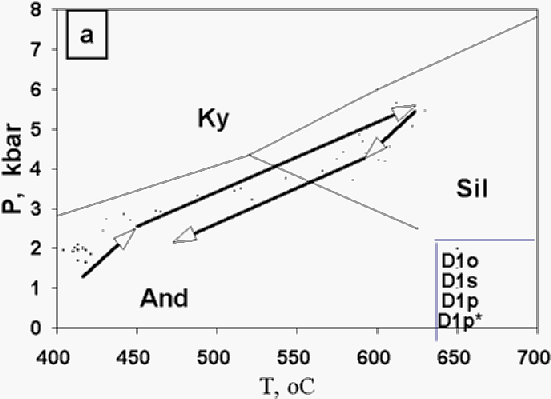
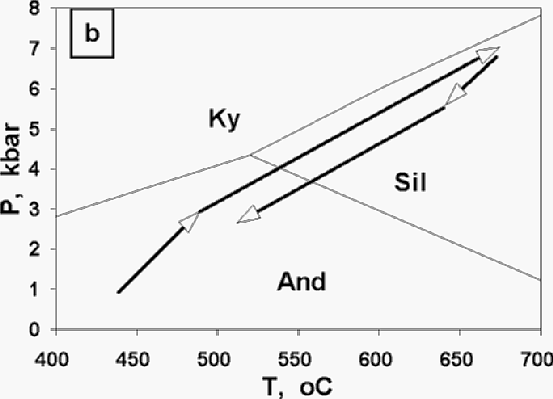
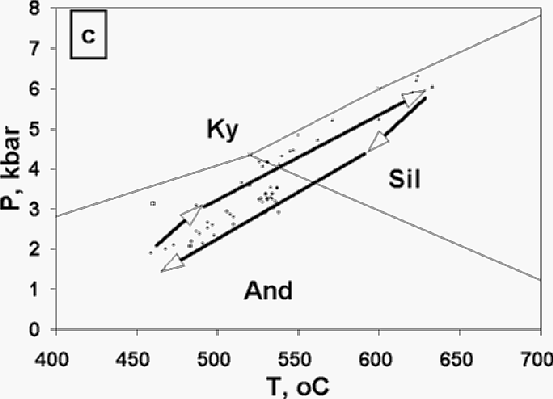
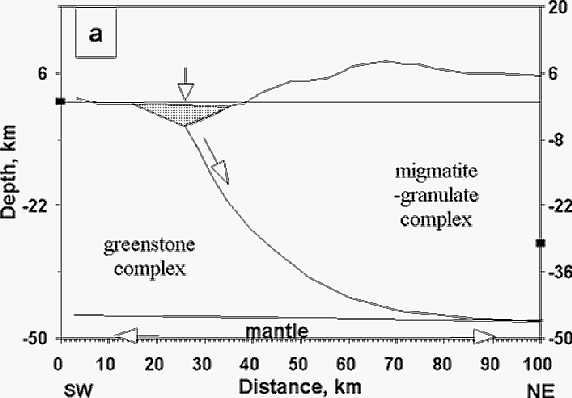
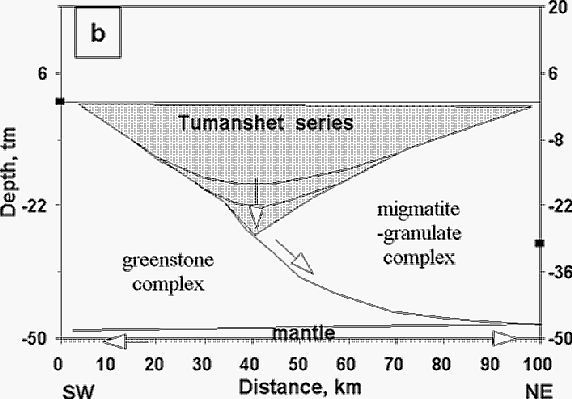
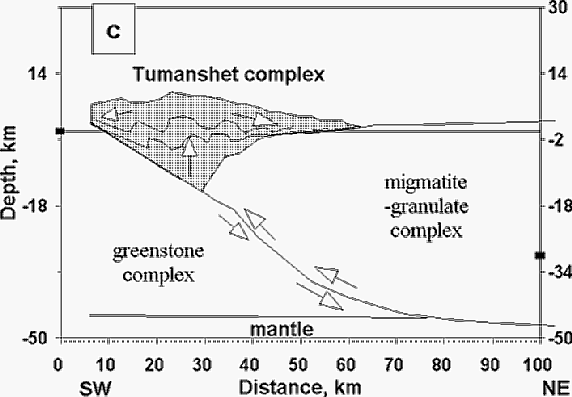
Fig.1. PT-trends of metamorphic evolution of the Tumanshet zonal complex. Southern (a), central (b), and northern (c) parts of the complex.
Fig.2. Geodynamic model of the Tumanshet zonal complex development (darkened).
(a) origin of the Tumanshet trough at the contact between granulitic and greenstone belts; (b) complete sedimentation and peak metamorphism; (c) uplifting and erosion.
Fed'kin V.V., Kitsul V.I., and Berezkin V.I. Mineral compositions and P-T conditions of biotite-garnet gneisses of the Batomga block.
Metamorphic conditions of biotite-garnet gneisses of the Batomga block, eastern Aldan Shield, were determined by mineral geothermobarometry, topological microprobe analysis of coexisting minerals, and paragenetic and thermodynamic analyses of mineral equilibria [1]. Specific features of the regional P-T evolution during the prograde and retrograde stages were revealed, and regional geothermal gradient in the Archean-Proterozoic earth crust was first estimated for this region. The chemical heterogeneity of the Fe-Mg silicates and feldspars, their zoning and
19
composition of mineral inclusions, studied by detailed microprobe analysis, reflect the evolution of metamorphic conditions during the simultaneous growth of coexisting mineral phases. Evidence of prograde changes of garnet composition are preserved only within restricted volumes of its large grains and, as a rule, have been obliterated by later rock transformations. The retrograde stage of metamorphism is recorded in most garnet, biotite, and feldspar grains. The P-T trends inferred from a number of rock samples from the Batomga block are similar and yield the ancient geothermal gradient of about 48oC/kbar. These data are consistent with the P-T conditions determined for eclogite rocks of the Archean gabbroic complex located in this region, and forming a single P-T trend. The general metamorphic conditions of the Batomga biotite-garnet gneisses range over the intervals T = 570-770oC and P = 6.7-8.5 kbar.
Reference:
Fed'kin V.V., Karamata S., and Cvetkovic V. Mineralogical geothermobarometry and evolution of metamorphism of amphibolites from two different terranes of Serbia.
Two different tendencies of the evolution of metamorphic conditions were found during petrologic studies of metamorphic complexes of Serbia: prograde metamorphism of Pre-Caledonian amphibolites of the Serbo-Macedonian Composite Terrane, investigated in the Batocina region, and retrograde P-T trends for the amphibolites and garnet-clinopyroxene rocks from the Bistrica region situated in the Dinaridic Ophiolite Belt Terrane [1].
The Batocina complex is composed of metasedimentary and metaigneous rocks: various types of gneisses with subordinate mica schists, small amphibolites lenses, marbles and quartzites. Many features indicate that the complex as a whole is a metamorphosed deep-to-shallow-water sedimentary unit, while the amphibolites correspond to ancient subalkaline within-plate tholeiites. The protolith was strongly metamorphosed during the Caledonian orogenesis (488+19 Ma), completely reworked during the Variscan orogenesis (» 275 Ma), and slightly reheated (up to 400 oC) by Early-Alpine (127-160 Ma) phases.
The mineral associations of the garnet amphibolites from the Batocina area preserve prograde metamorphism traces at different depth levels from T=430-530oC and P=5-8.2 kbar to T=620-680oC and P=9-10 kbar (Fig.1). The field marked as "BC" corresponds to the initial metamorphic conditions of the Batocina region. The main tendency of the prograde evolution of Batocina metamorphism appears as a shift of P-T trends from the beginning to the end of the metamorphic event to lower pressure level and change their slope during mineral crystallization at the same pressure level to a sharper position. Most of the prograde P-T paths for individual mineral pairs, inclusions and samples of the Batocina amphibolites extend into the field bounded by the "Final Geotherm" line. However, some of them continue to higher temperature areas, defined by the "Intermediate Geotherm" line.
Fig.1 Evolution of metamorphic conditions of formation of amphibolites from the Batocina complex (BC) and Bistrica Ultramafic Block (BUB). Fields DC and BUB are the initial metamorphic conditions of the complex formation. Ia, Ib, Ic, and Id - subisobaric P-T trends for the "Peak Geotherm" shift.
20
The Bistrica ultramafic block and associated amphibolites are located in the central part of the Dinaridic Ophiolite belt. The significant petrological role of these rocks is defined by their position in the Upper Triassic - Upper Jurassic oceanic realm which began to close in Middle Jurassic. Probably by subduction beneath the "hot" ultramafics the down pulled oceanic crust was metamorphosed. In contrast to the Serbo-Macedonian massif, which was regionally metamorphosed in 450-500 Ma, the Dinaridic Ophiolite belt is of Alpine age and the time of metamorphism in the subduction zone was lasting only some tens of Ma about 180 Ma ago.
Relict Grt-Cpx and Grt-Am assemblages from the Bistrica ultramafic block indicate retrograde PT trends of their formation from T=740-830oC and P=8-10 kbar to T=570-650oC and P=3.5-7.0 kbar. According to mineral compositions the maximum P-T conditions of metamorphism for Grt-Cpx and Grt-Am rocks were calculated from the core of Fe-Mg coexisting silicates (Grt, Cpx, Am). A set of these points supplies a curve of the highest grade of metamorphism for the studied complex and, from our viewpoint, reflects a segment of the ancient geotherm (Fig.1, "Peak Geotherm" line). The retrograde stage of the thermal evolution of the Bistrica rocks seems to have been interrupted from time to time by tectonic movements, which resulted in the stepwise ascent of the Bistrica complex to the surface. This is particularly evident in, for example, the Am-Pl-Cpx paragenesis in which phase compositions slightly react when P-T conditions change. In the P-T diagram, the set of points of this paragenesis shows the lasting and discrete character of retrograde changes in the amphibolites of Bistrica. Four such steps (depth levels) were revealed in a wide range of temperatures by applying Am-Cpx-Pl geothermobarometry.
Both tendencies of metamorphism for amphibolites from the Batocina complex and the Bistrica ultramafic block result in a single P-T trend which correspond to the metamorphic conditions on the final stage of geological history of the region and reflect the position of the geothermal gradient line (Fig.1, "Final Geotherm" line). This trend reflects an interesting case of geological convergence of processes originated in different geological units, at different times and resulting during defferent long processes, but ending with similar P-T conditions.
Reference:
Perchuk L.L., Podladchikov Yu.Yu., Polyakov A.N. Geodynamic modeling of some metamorphic processes.
Theoretical background was developed for the explanation of gravity redistribution effect at the PT-parameters of granulite metamorphism. It was first shown that geological processes can be described with chain-reaction equations. Therewith, the viscous friction effect providing rock heating at high pressures was taken into account. Such a model can explain the high temperatures (in some places, up to 1000oC) of some granulitic complexes, which are not associated with any other heat sources. The advection physical model (or monocyclic convective model) for heat and mass transfer in highly visous media (in lithosphere) was developed. It was established that in gravity ordering, viscous dissipation can result in rising temperature, and subsequent conductive processes provide the subisobaric cooling of granulitic complexes (so common in nature). The software for geodynamic modeling of metamorphic processes in greenstone belts and granulites was developed. The models were createdfor the gravitational redistribution of rocks and granulite formation after greenstone belts. The problem of interaction of rocks with different rheologic properties was first solved by theoretical considerations. The theory was applied to the explanation of the mechanisms of magma intrusion, gravitational redistribution of rocks, rifting, etc.
Reference:
Perchuk L.L., Gerya T.V., and Safonov O.G. A model of charnockitization of gneiss complexes.
The roles of pressure, temperature, bulk rock composition, water, carbon dioxide, and alkili activities during charnockitization of gneiss complexes were determined on the basis of detailed study of reaction textures, mineral zoning, and thermodynamic calculations. D.S.Korzhinsky's hypothesis on alkili mobility in the process was first corroborated at the quantitative level. K-feldspar rims of plagioclase were obtained experimentally (700oC and 5.5 kbar) through the charnockitization mechanism. Thus, Korzhinsky's reaction was first realized in experiment, and the perfectly mobile behavior of potassium in charnockitization was confirmed.
The model for charnokitization of gneiss complexes was developed, which make it possible to determine temperature, pressure, water, carbon dioxide, and alkali activities, and the charnockitization mechanism from the rock texture and compositions of coexisting minerals. The methods of study of thermodynamic regime and charnockitization mechanism were proposed. The universal character and feasibility of the model was testified for both charnockite-enderbite-metabasite-gneiss complexes (Sharyzhalgai Complex, SW Baikal Region; Kanskii Complex, Yenisei Range; Sulkava Complex, S. Finland, etc.) and spotted ("arrested") charnockites of S. India and Sri Lanka. Charnockitization was established to occur at the retrograde metamorphic stage at temperatures 600-750oC and pressures 3.5-6 kbar. This process is characterized by the perfectly mobile behavior of water, alkilis, and,
21
in some cases, calcium and is not acompannied by any significant water activity decrease compared to ordinary regional metamorphism [1,2].
References:
Podlesskii K.K. P-T-XMg relations in aluminous granulites.
Phase relations involving solid solutions of cordierite (crd), garnet (grt), orthopyroxene (opx), sapphirine (spr) and spinel (spl), and end-member minerals sillimanite (sil) and quartz (qtz) were analyzed in terms of stability of the mineral assemblages in the system FeO-MgO-Al2O3-SiO2 to provide a basis for the interpretation of mineral reactions in aluminous granulites. Thermodynamic properties of reactions involving Fe2Al4Si5O18 (CrdFe),Mg2Al4Si5O18 (CrdMg), Fe3Al2Si3O12 (Alm), Mg3Al2Si3O12 (Prp), FeSiO3 (Fs), MgSiO3 (En), Al2O3 (OK), FeAl2O4 (Hrc), MgAl2O4 (Spl), Mg4Al8Si2O20 (slica-rich sapphirine end-member, SS), Mg3Al10SiO20 (alumina-rich sapphirine end-member, SA), Al2SiO5, and SiO2 were estimated from exprimental data (Gerya et al. 1996), and the empirical calibration of the Fe-Mg exchange equilibrium between sapphirine and garnet (Podlesskii 1992) was employed to estimate the properties of the Fe-sapphirine-bearing reactions. The approach proposed by Aranovich and Podlesskii (1989) was used to describe the cordierite-bearing reactions, and the phase relations were considered for two extreme cases: first, that for cordierite completely saturated with water (water-saturated cordierite) and, second, that for cordierite with zero fluid content ("dry" cordierite).
The calculated P-T grid (Fig.1) has four stable invariant points [spl], [opx], [sil] and [crd], with the topology being similar to that proposed by Hensen and Harley (1990), except that they indicated stability of [qtz] instead that of [crd], as implied by this work. A characteristic feature of the present quantitative estimation is that the invariant points [spl], [opx], and [sil] are located within a very narrow temperature range at pressures almost constant for both water-saturated and "dry" cordierite cases.
Incorporation of fluid particles into channels of the cordierite structure has been estimated to increase the upper pressure stability limits of crd-bearing assemblages from 5-6.5 kbar under fluid-absent conditions to 9.5-11.5 kbar under water-saturated conditions. The invariant points spl], [opx], and [sil] shift along the crd-absent reaction curves towards higher temperatures under water-saturated conditions (from > 900�C to > 1100�C), thus coming closer to the most high-temperature high-pressure point [crd]. This may imply that changes in fluid activity during metamorphism might have played an important role in forming significant diversity or reaction textures observed in aluminous granulites.

Fig.1. P-T diagrams for the FeO-MgO-Al2O3-SiO2 system showing the stability relations involving grt, spl, opx, spr, qtz, sil, and crd (water-saturated cordierite for the upper diagram and fluid-absent cordierite for the lower diagram).
Numbered reactions: 1- grt + spr + qtz = spl + crd, 2-spr + qtz = grt + crd + sil, 3 - opx + spr + qtz = grt + crd, 4 - grt +opx+sil=spl+spr, 5 - grt + sil = spl + opx + qtz, 6- opx + sil = spl+ spr + qtz. Arrows show at invariant points. Dash lines - reactions referring to the invariant point [Prp,Spl] for the MgO-Al2O3-SiO2 system; dash-dot line - the univariant reaction Alm+Sil=Hrc+Qtz for the FeO-Al2O3-SiO2 system. For all equations, assemblages on the left are stable on the high pressure side.
According to the derived relationships, XMg of coexisting phases increases in a row garnet, spinel, orthopyroxene, sapphirine, cordierite, with garnet and spinel demonstrating inversions. In the P-T field (Fig.1), spinel becomes the most Fe-rich phase in the stability field of Hrc+Qtz in
22
the system FeO-Al2O3-SiO2, while garnet is the most Fe-rich phase in the stability field of Alm+Sil. The XMg of coexisting minerals jointly increase along univariant reaction curves for opx- and sil-absent reactions towards invariant point [spl], for qtz- and spr-absent reactions towards invariant point [opx], for opx- and spr-absent reaction towards invariant point [sil], for opx-, sil- and spr-absent reactions towards invariant point [crd]. In other cases, XMg of coexisting minerals either decrease jointly along univariant reaction curves towards corresponding invariant points, or demonstrate more complex behavior, when maxima or minima of XMg occur for some minerals. Although, in general, XMg for garnet increases with increasing pressure, that is not a universal regularity.
References:
Fed'kin A.V. Petrology of metamorphic rocks of Yenisei ridge in the transition zone from the granulite block to the greenstone belt.
Based on the methods of structural-paragenetic analysis and mineralogical geothermobarometry, the evolution peculiarities of PT parameters of metamorphism and deformation of the Yenisei ridge greenstone complex (Yukseevskii series) were revealed in relation to the thermodynamic and geodynamic evolution of the Kanskii granulite block. A complex multistage history of the evolution of Yenisei ridge metamorphism was studied in detail on the maximally metamorphosed granulite formations of the Kanskii series [1-3] and is not known enough in the conjugated with them more low temperature rocks of Yenisei and Yuksei series metamorphosed under the conditions of amphibolite, epidote and greenstone facies. Moreover, it remains not quite clear the problem of structural and geodynamic relations of the rocks of different series at the different stages of geological evolution.
Metamorphic and sedimentary-effusive formations of the Yukseevskii series are represented by amphiboles, garnet-bearing and quartz-feldspar rocks (acid metaeffusives), amphibole and biotite-amphibole schists. Several horizons of quartzites and marbles are present in the thickness. The rocks of the Yukseevskii series are cut by the stratified bodies of metagabbroids, veins of synkinematic granitoids (transformed to granite-gneisses), disgneissed aplites and pegmatites. The upper part of the section is represented by microamphibolites, feldspar quartzites, metaeffusives and green schists. They are cut by the concordant subvolcanic bodies of acid composition, bodies of amphibolized gabbroids, several postkinematic intrusions of diorites and plagiogranites.
As a result of a detailed microstructural analysis of the rocks of the thickness studied, some generations of garnets and amphiboles were distinguished which belonged to the different stages of mineral formation: syndeformation and postdeformation ones. A detailed study of the chemical composition of these phases and their zoning (based on more than 500 microprobe analyses) allowed to reveal major regularities of the alteration in the physico-chemical conditions of the greenstone belt metamorphism in the process of its formation. Experimentally and theoretically calibrated geothermometers and geobarometers of the interconcordant system of thermodynamic constants 'Geopath' were used for the estimation of P-T parameters [2].
In the process of geological evolution of the Yenisei ridge, greenstone belt of the Yukseevskii series experienced two-stage metamorphism under the conditions of amphibolite and greenstone facies. Progressive metamorphic stage took place at T=530-730oC and P=5.2-6.8 kbar, regressive one at T=730-550oC and P=1.5-4.1 kbar. Metamorphic and geodynamic evolution of the granulite (Kanskii) block and greenstone (Yukseevskii series) complexes are related. Granulites of the Kanskii block were the heat source at the metamorphism.
Based on the obtained P-T trends of the evolution of Yukseevskii complex metamorphism the following model of the greenstone thickness evolution has been proposed. With the subisobaric cooling of the Kanskii complex the subsidence of the more dense rocks of the Yukseevskii series to the depth and increase in P-T metamorphic parameters took place. In the contact zone of Kanskii granulite block and rocks of the greenstone complex the latter are involved by granulites in the uplift process followed by cooling. Granulites of the Kanskii block were the heat source at the metamorphism of the rocks of greenstone belt, i.e. the thermodynamic and geodynamic evolution of these two complexes are conjugated.
References:
23
granulites of the Angaro-Kanskii ridge.// Vestnik MSU Ser.4, Geology, N.5, pp.3-12.
Shmulovich K.I. and Zonova I.A. The fluid transport in metamorphism.
The migration rate of fluid inclusions in quartz was experimentally measured at different thermogradient conditions [1]. The rate of inclusion migration through the dissolution-precipitation mechanism is as much as 1 cm per million years at normal thermal gradient (30oC/km) and stress no more than the ultimate strength of quartz. Thus, the absence of water-salt inclusions in highly metamorphosed rocks is a consequence of the fluid migration to the intergrain space rather than the lack of fluid in the mineral formation. The experimental data indicate that even one metamorphic stage is sufficient for all the quartz inclusions 5 and more in size to leave the quartz crystals, except CO2-rich inclusions.
and more in size to leave the quartz crystals, except CO2-rich inclusions.
Reference:
24